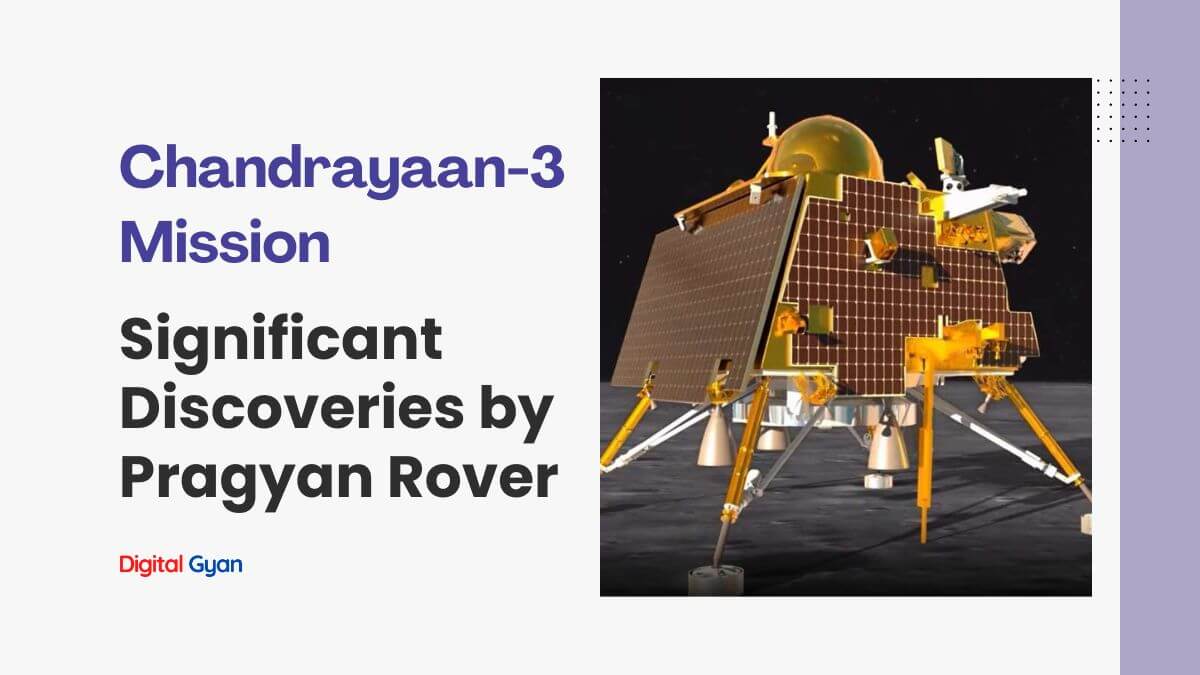Chandrayaan-3 Mission: Significant Discoveries by Pragyan Rover
Chandrayaan-3, the third lunar mission by India, achieved a successful soft landing at the southern pole of the Moon on August 26, 2023.
At 18:04 IST (12:34 UTC), the lander named Vikram and the rover named Pragyan successfully made contact with the lunar surface.
The designated landing site for the Vikram lander in the Chandrayaan-3 mission has been named Shiv Shakti Point. The lunar feature under consideration is situated inside the Sinus Iridum region, characterized by its relatively level terrain in close proximity to the southern pole of the Moon.
The appellation “Shiv Shakti” is a composite term derived from the amalgamation of the Hindu deity Shiva and the Sanskrit lexeme denoting potency or authority. The selection of this symbol was made with the intention of symbolizing the resilience and resolve exhibited by the Indian populace and the ISRO team in their remarkable accomplishment.

The Vikram lander and the Pragyan rover are presently operational at the Shiv Shakti Point. The rover is engaged in the exploration of the lunar surface and the acquisition of data, while the lander is fulfilling the role of facilitating communication and navigation assistance. The data acquired during the Chandrayaan-3 mission would facilitate scientists in enhancing their comprehension of the lunar south pole and its prospective resources.
Significance of Chandrayaan-3 Mission for India
The successful landing of the lander Vikram and the rover Pragyan marked a significant achievement for India, establishing the country as the pioneer in lunar exploration by becoming the first to accomplish a spacecraft landing on the southern pole of the moon.
The southern polar region of the Moon remains relatively unexplored, with limited knowledge regarding its characteristics. However, there is a prevailing belief that this region has significant deposits of water ice. The data acquired by the Chandrayaan-3 mission would facilitate the enhanced comprehension of the lunar south pole and its prospective resources among the scientific community.
The Chandrayaan-3 mission encompasses a lunar orbiter that will persistently investigate the Moon over an extended period of several months. The primary objectives of the orbiter include the cartographic analysis of the lunar surface, the investigation of the lunar atmosphere, and the identification of water ice deposits.
The achievement of Chandrayaan-3 signifies a significant milestone in the trajectory of India’s space program. The aforementioned event serves as a testament to India’s burgeoning prowess in the field of space exploration and its unwavering dedication to the pursuit of scientific inquiry. The mission has also served as a significant source of national pride for the Indian populace, thereby fostering inspiration among a fresh cohort of scientists and engineers.
Here are some of the key achievements of Chandrayaan-3:
- First spacecraft to land on the lunar south pole.
- First spacecraft to carry a rover to the lunar south pole.
- First spacecraft to map the lunar south pole in detail.
- First spacecraft to study the lunar south pole’s atmosphere and water ice.
The Chandrayaan missions have made significant contributions to our understanding of the Moon. They have mapped the lunar surface in detail, studied its composition, and searched for water ice. The data collected by these missions will help scientists to better understand the Moon’s formation and evolution, and its potential resources.
The success of the Chandrayaan missions has also demonstrated India’s growing capabilities in space exploration. India is now a major player in the global space community, and its lunar missions have inspired a new generation of scientists and engineers.
The future of India’s lunar exploration programme is bright. The country is planning to launch several more lunar missions in the coming years, including one to send a human to the Moon. These missions will continue to push the boundaries of space exploration and help us better understand our nearest neighbour.
Key Discoveries by Pragyan Rover
The Pragyan rover has only been operating on the lunar surface for a few weeks, so it has not yet revealed a lot of information. However, it has already made some interesting discoveries, including:
- The presence of sulphur in the lunar surface near the south pole.
- The presence of oxygen in the lunar surface.
- The presence of other elements, such as aluminium, calcium, ferrous (iron), chromium, titanium, manganese, and silicon.
- The absence of hydrogen so far.
The discovery of sulphur is significant because it is a key element in the formation of water ice. The presence of oxygen is also significant, as it is a key component of water. The discovery of other elements is also important, as it will help scientists better understand the lunar surface’s composition.
The absence of hydrogen so far is also interesting. Hydrogen is a light element that is thought to be abundant on the Moon. The fact that the Pragyan rover has not yet detected hydrogen suggests that it may be trapped in the lunar regolith, or that it may be in a form that is not easily detectable.
The Pragyan rover is still in its early stages of operation, so it is likely to make more discoveries in the coming months. The data collected by the rover will be invaluable to scientists who are studying the Moon and its potential resources.
Here are some of the objectives of the Pragyan rover:
- To study the composition of the lunar surface near the south pole.
- To search for water ice.
- To study the lunar atmosphere.
- To study the lunar geology.
- To test new technologies for lunar exploration.
The Pragyan rover is a small but important part of India’s lunar exploration program. It is the first Indian rover to operate on the Moon, and it is helping to pave the way for future missions.
Conclusion
The success of Chandrayaan-3 is a major step forward for India’s space programme and for lunar exploration. The mission will provide valuable data that will help scientists better understand the Moon and its potential resources. It will also inspire a new generation of scientists and engineers to pursue careers in space exploration.

